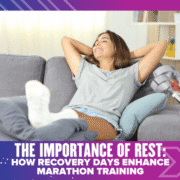Running Form: Small Adjustments for Big Gains
When it comes to marathon training, most runners focus on building endurance, increasing mileage, and improving speed. But there’s another critical factor that can significantly impact your performance and reduce your injury risk: running form. While it might seem like a small detail, optimizing your form can lead to big gains in efficiency, reduce the stress on your muscles and joints, and help you avoid the common injuries that plague long-distance runners.
In this blog, we’ll explore several key techniques to improve your running form, reduce injury risk, and make every stride count.
1. Posture: Stand Tall, Run Tall
The foundation of good running form starts with proper posture. A slight lean forward from your ankles (not your waist) will help you maintain balance and momentum without wasting energy. Imagine a straight line from your head to your heels, as if you’re being gently pulled upward by a string. This alignment allows for more efficient use of your muscles, reducing the strain on your back and core.
Tip: Avoid slouching or leaning too far forward, as this can lead to lower back pain and poor running mechanics. Keep your chest open, shoulders relaxed, and spine neutral.
2. Foot Strike: Aim for a Midfoot Landing
Where and how your feet hit the ground is a key factor in preventing injury and improving efficiency. A common mistake among new runners is overstriding, where the foot lands too far in front of the body. This causes unnecessary braking forces and puts extra strain on your joints. Instead, aim for a midfoot strike, where your foot lands directly beneath your body.
Tip: To achieve a midfoot strike, focus on keeping your strides short and light. You should feel like you’re “falling” forward slightly with each step rather than pushing yourself forward with each stride.
3. Cadence: Find Your Rhythm
Cadence refers to the number of steps you take per minute. A higher cadence (typically around 170-180 steps per minute for most runners) reduces the risk of injury and improves running efficiency. When your cadence is too low, you may tend to overstride, which increases the impact on your knees and hips. A quicker cadence helps to reduce this impact, keeping your body in a better position to absorb shock.
Tip: Use a metronome or running app to monitor your cadence. Try to gradually increase your steps per minute to a target of around 180. Shortening your stride and increasing cadence will allow you to use less energy per step.
4. Arm Swing: Keep It Relaxed and Efficient
Your arms play a crucial role in maintaining your running form and rhythm. If your arms are stiff or cross your body, you’ll waste energy and risk injury. The key is to keep your arms relaxed, with your elbows bent at about 90 degrees. Your hands should move in a straight line, not crossing over your chest. This helps propel you forward efficiently while reducing strain on your shoulders and upper body.
Tip: Imagine that you’re gently holding a small ball in each hand, keeping them relaxed. Focus on swinging your arms in sync with your legs, using them to generate momentum and maintain your rhythm.
5. Core Engagement: Strengthen Your Center
A strong core is the foundation of good running form. When you engage your core, you’re able to maintain good posture, prevent slouching, and avoid excessive tilting of your pelvis, which can lead to lower back pain. A strong core also helps with balance and stability, especially when running on uneven terrain.
Tip: During your runs, focus on gently pulling your belly button toward your spine, keeping your core engaged without over-tensing. This will help you maintain a stable and upright posture.
6. Stride Length: Short and Sweet
Many runners think that lengthening their stride will help them go faster, but this often leads to overstriding, where the foot lands too far in front of the body. This can put excessive stress on your knees and hips, increasing the risk of injury. Instead, focus on a short, quick stride where your foot lands under your hips, not in front of you.
Tip: Think about running in a straight line with your footfall just below your body’s center of mass. Avoid reaching out with your foot and focus on maintaining a slight bend in your knees as you land.
7. Hip Position: Keep Them Aligned
Your hips are the engine of your running form, and keeping them in proper alignment is key to avoiding injuries like IT band syndrome or hip flexor strain. Misalignment of the hips can cause uneven stress on your knees, ankles, and lower back, leading to pain and discomfort.
Tip: Pay attention to your pelvis during your runs. Your hips should remain level and not tilt too far forward or backward. Engaging your core and slightly tilting your pelvis to a neutral position can help maintain better alignment throughout your run.
8. Relaxation: Loosen Up and Save Energy
One of the most common mistakes runners make is holding unnecessary tension in their bodies. Tension in your face, shoulders, arms, or hands can waste energy and increase fatigue. You should aim to be relaxed while running, particularly in your upper body. Clenching your fists or tightening your jaw can waste valuable energy that should be used to propel you forward.
Tip: Periodically check in with yourself during your run and consciously relax your hands, shoulders, and face. Think of running as a fluid motion where your body moves effortlessly.
9. Breathing: Find Your Breath Rhythm
Breathing might seem automatic, but learning to control your breathing rhythm can improve your performance and help you run more efficiently. Focus on deep belly breathing rather than shallow chest breathing, which can lead to fatigue and cramping.
Tip: Try to establish a breathing pattern that matches your cadence. For example, inhale for two steps, exhale for two steps. This will help you maintain a steady flow of oxygen, reduce side stitches, and improve endurance.
Conclusion: Small Adjustments, Big Gains
Improving your running form doesn’t require drastic changes or expensive gear. By making small adjustments, such as improving posture, increasing cadence, and engaging your core, you can enhance your running efficiency, reduce the risk of injury, and ultimately perform better during your marathon.
Remember, running is a skill that takes time to develop, so be patient with yourself as you work on these techniques. Practice them during your training runs, and over time, you’ll notice that you’re running smoother, faster, and with less effort. By focusing on proper form, you’re setting yourself up for a more successful and injury-free marathon experience.
Happy running, and here’s to reaching new personal bests!















